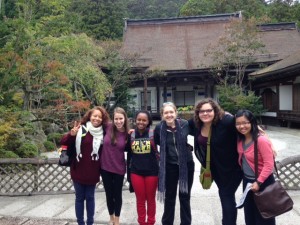We are settled into Koya-san for the next three days, with the students free to explore the nearly 50 temples and shrines that dot the hillsides of this 1200 year old mountain town. Abby says she is still contemplating our hike up to the waterfall at Kumano, turning over the difference between walking to get somewhere in particular, or to get into shape, and moving for an interior purpose. It was a profound experience, she says.
Late in the afternoon we walked the cemetery at Okunoin, the full hour up to the mausoleum at the top where Kobo Daishi, the monk who founded the monastic enclave at Koya sits in eternal meditation. Perhaps as many as 500,000 people have been buried at Koyasan over the last millenia. Prof. Glassman’s latest book was on images of Gizo, a Buddha who is often invoked as a protector of children. There are many Gizo images in the graveyard, and we enjoyed Glassman’s commentary as we climbed. He told the students about discovering these images just before he began college.
Alex noted that it’s an odd feeling to walk a graveyard as a tourist, in our case unable to read the inscriptions. This particular cemetery, with its ancient cedar trees and thick moss blankets draped over 15th century cenotaphs invited reflection.
Prof. Glassman celebrated a significant birthday today, and we managed to find someone to bake two chocolate cakes and (the more difficult task) birthday candles in tiny Koya. Our monastic hosts provided a lighter and knife to cut the cake (though the students were all set to tackle the latter problem with chopsticks).



